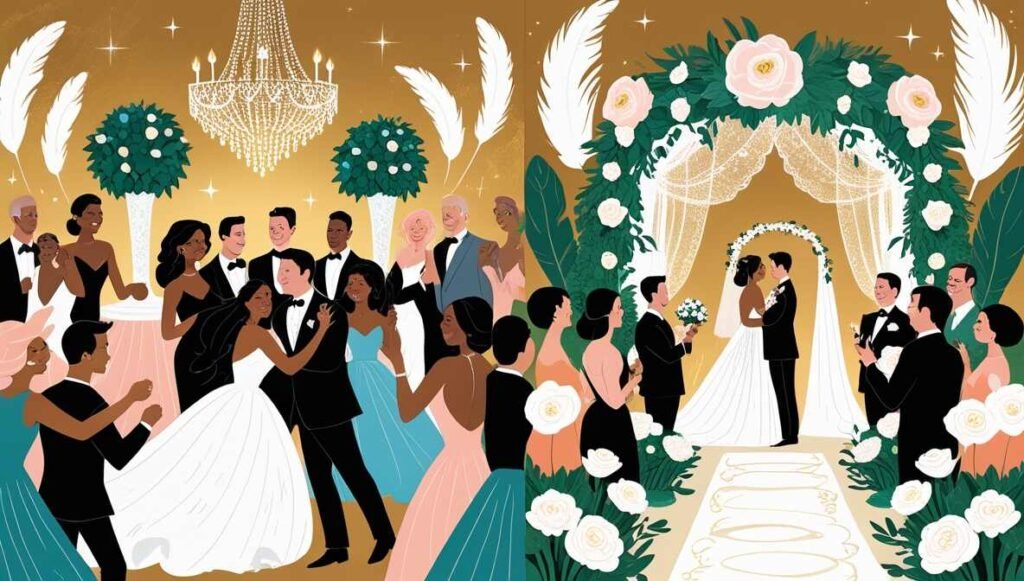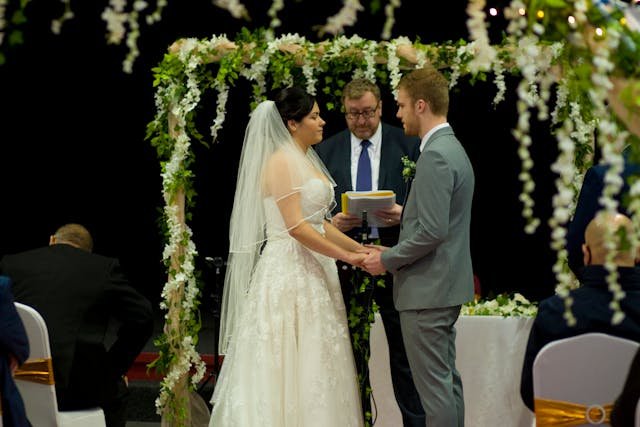What’s the difference between a wedding ceremony and a wedding reception? While they’re often mentioned together, these two essential parts of a wedding serve distinct purposes and create unique experiences for the couple and their guests.
In this article, we’ll dive into the wedding reception vs ceremony comparison, exploring the roles, atmospheres, and traditions that make each event special. While the ceremony is the heart of the celebration where vows are exchanged and love is formalized, the reception is the party that follows, filled with joy, food, and dancing.
By understanding the difference between wedding reception and ceremony, couples can better plan their big day and ensure every moment reflects their unique love story. Ready to explore how these two events work together to create unforgettable memories? Let’s get started!

What Is a Wedding Ceremony?
A wedding ceremony is the formal or symbolic event where a couple is officially married, marking the start of their journey together. It’s the heart of the wedding day, filled with meaningful traditions, heartfelt moments, and often a touch of spirituality or cultural significance.
Key Components of a Wedding Ceremony
- Exchange of Vows and Rings
One of the most significant moments in any wedding ceremony is when the couple exchanges their vows. This personal declaration of love and commitment is often accompanied by the giving of rings, symbolizing eternity and unity. - Religious or Cultural Traditions
Many ceremonies incorporate unique traditions based on the couple’s religious or cultural backgrounds. From lighting a unity candle to tying a knot or jumping the broom, these elements make the ceremony deeply personal and meaningful. - Processional and Recessional
The ceremony typically begins with a processional, where the wedding party and couple make their grand entrance, often accompanied by music. Similarly, the recessional marks the joyful exit of the newlyweds and their party, symbolizing the start of their new life. - The Officiant’s Role
The officiant, whether a religious leader, celebrant, or close friend, guides the couple through the ceremony. They oversee the exchange of vows, provide inspirational words, and legally or symbolically unite the couple.

Typical Locations for a Wedding Ceremony
Wedding ceremonies can take place in various locations depending on the couple’s preferences and traditions:
- Churches or Temples: Perfect for religious ceremonies steeped in tradition.
- Gardens or Beaches: Ideal for couples seeking a natural, scenic backdrop.
- Event Venues: Offer flexibility for personalized ceremonies.
A wedding ceremony meaning goes far beyond the exchange of rings; it’s a celebration of love and unity, filled with cherished elements of a wedding ceremony that reflect the couple’s values and dreams. Whether held in a grand cathedral or on a serene beach, this special event sets the tone for the entire wedding day.
What Is a Wedding Reception?
A wedding reception is the lively celebration that follows the ceremony, where family and friends gather to honor the newlyweds. It’s the part of the day filled with joy, laughter, and memorable moments, allowing everyone to relax and enjoy the festivities after the formalities of the ceremony.
Key Components of a Wedding Reception
- Cocktail Hour
The reception often begins with a cocktail hour, giving guests time to mingle and enjoy drinks and appetizers while the couple takes photos or prepares for their grand entrance. - Dinner, Speeches, and Toasts
Dinner is typically a highlight of the wedding reception, ranging from buffet-style spreads to plated meals. Speeches and toasts from the couple, family, and friends add a personal and emotional touch to the celebration. - Dancing and Entertainment
A reception isn’t complete without dancing! Whether it’s the couple’s first dance, the parent dances, or a lively dance floor for all guests, music and entertainment are central to the party atmosphere. - Cutting the Cake
The cake-cutting ceremony is a cherished tradition symbolizing the couple’s first task together. It’s also a sweet moment guests look forward to—both figuratively and literally!
Typical Reception Venues
Receptions are held in a variety of venues, depending on the couple’s vision and guest count:
- Banquet Halls: A classic choice for large, formal celebrations.
- Outdoor Spaces: Gardens, vineyards, or beaches provide scenic, open-air options.
- Restaurants: Ideal for intimate gatherings or those focused on gourmet dining.
A wedding reception meaning extends beyond just the party—it’s the time for everyone to celebrate love, create memories, and share in the couple’s joy. With its vibrant wedding reception events, this gathering is often the most talked-about part of the day, making thoughtful reception planning tips crucial to its success.

What Are The Key Differences Between a Wedding Ceremony VS Reception
The wedding ceremony vs reception differences highlight how these two parts of the wedding day serve distinct purposes while complementing one another. Here’s a detailed comparison to help understand their unique roles.
| Aspect | Wedding Ceremony | Wedding Reception |
| Purpose | Officially marry the couple. | Celebrate the marriage with family and friends. |
| Tone | Formal, sacred, and emotional. | Festive, relaxed, and celebratory. |
| Attire | Formal attire, including wedding gowns and suits. | May involve outfit changes for the couple or guests. |
| Activities | Vows, officiant’s speech, exchanging rings. | Dancing, speeches, dining, cake-cutting. |
| Length | Usually shorter (30 minutes to 1 hour). | Longer, often lasting several hours. |
| Setting | Often held in churches, gardens, or beaches. | Typically held in banquet halls, restaurants, or outdoor spaces. |
| Focus | Centered on the couple’s union and vows. | Focuses on entertaining and celebrating with guests. |
Both events are essential to the wedding day, but as this ceremony vs reception comparison shows, they fulfill very different needs. While the ceremony brings solemnity and meaning, the reception adds fun and festivity, creating a perfect balance for the celebration of love.
Can You Combine a Wedding Ceremony and Reception?
Combining a wedding ceremony and reception is a growing trend, particularly for casual or smaller weddings. This approach allows couples to simplify their big day, save on costs, and create a more intimate and seamless celebration. Instead of separate events, the ceremony flows directly into the reception, often in the same location.
Examples of Combined Events
- Backyard Weddings: Hosting both events in a cozy, familiar setting creates a relaxed atmosphere and reduces the need for travel.
- Elopements with Intimate Dinners: After a private ceremony, couples can celebrate with close family and friends over a meaningful meal.
- Rustic or Outdoor Venues: Farms, vineyards, or beachside locations are perfect for hosting both the vows and the party in one place.
Pros of Combining Ceremony and Reception
- Cost-Effective: One venue and streamlined decor can significantly lower expenses.
- Convenience: Guests don’t need to travel between locations.
- Intimacy: Smaller guest lists and informal settings create a more personal experience.
Cons of Combining Ceremony and Reception
- Less Formality: Combining events may lack the traditional solemnity some couples desire for the ceremony.
- Logistical Challenges: Managing transitions from ceremony to reception in the same space requires careful planning.
- Limited Guest Count: These setups often work best for smaller weddings.
By understanding the nuances of combining ceremony and reception, couples can decide if this approach aligns with their vision for their wedding day.
How to Plan a Wedding Ceremony vs Reception
Whether planning a formal ceremony or a lively reception, having a clear roadmap ensures both events reflect your unique love story. Here are some tips for each.
Ceremony Planning Tips
- Choosing an Officiant: Decide on someone meaningful to you, whether it’s a religious leader, celebrant, or friend authorized to officiate.
- Selecting a Venue: Choose a location that aligns with your theme and accommodates your guest count, such as a church, garden, or beach.
- Writing Vows and Preparing Rituals: Personalize your ceremony with heartfelt vows and cultural or religious traditions that resonate with you.
Reception Planning Tips
- Creating a Guest List and Seating Arrangement: Decide who you want to celebrate with and organize seating to encourage mingling.
- Deciding on a Menu and Entertainment: Choose food and entertainment that suits your style, whether it’s a formal dinner, buffet, or live music.
- Timing the Events: Plan a timeline for dinner, speeches, toasts, and dances to keep the event flowing smoothly.
With thoughtful preparation and creativity, both your ceremony and reception—or even a combined celebration—can be unforgettable, showcasing your love story in every detail.
Cultural and Religious Variations
Wedding ceremonies and receptions vary significantly across cultures and religions, reflecting traditions, values, and beliefs unique to each community. These differences influence everything from the structure of the events to their length, activities, and attire.
Cultural Wedding Ceremonies and Receptions
- Indian Weddings:
Indian weddings are known for their vibrant, multi-day celebrations.- Ceremonies: Typically involve intricate rituals such as the saptapadi (seven steps around the fire) and other cultural traditions.
- Receptions: Often lavish events featuring grand buffets, music, and traditional dances like the Sangeet.
- Western Weddings:
Western weddings are usually single-day events with distinct ceremonies and receptions.- Ceremonies: Formal and emotional, often held in churches or outdoor venues.
- Receptions: Festive gatherings with dining, toasts, and dancing, often capped with the couple’s grand exit.
- Religious vs Secular Ceremonies:
- Religious Ceremonies: Rooted in faith, such as Christian weddings in churches or Jewish weddings under a chuppah.
- Secular Ceremonies: Focus on personal vows and symbolic gestures, often held in non-religious venues like gardens or beaches.
Budget Considerations for Wedding Ceremony and Reception
Understanding the cost breakdown of ceremonies and receptions is crucial for effective wedding planning. While the ceremony is generally simpler and less expensive, receptions can significantly increase the overall budget due to catering, entertainment, and venue expenses.
Wedding Ceremony Costs
- Venue: Churches, gardens, or courthouses can range from free (for members) to $1,000 or more for special locations.
- Officiant: Fees vary from $100 to $500, depending on the officiant and location.
- Decorations: Floral arrangements, seating, and altars typically cost $500 to $1,500.
Wedding Reception Costs
- Catering: Food and beverages can cost $50 to $150 per person, depending on the menu.
- Entertainment: DJs, live bands, or performers often cost $1,000 to $5,000.
- Venue Rental: Ranges from $2,000 to $10,000, depending on the location and amenities.
Budget-Friendly Tips for Ceremonies and Receptions
- For Ceremonies:
- Opt for free or low-cost venues like parks or family properties.
- Use seasonal flowers or DIY decor to save on floral costs.
- For Receptions:
- Consider buffet-style catering instead of plated meals.
- Host a smaller guest list to reduce food and venue expenses.
- Use a playlist instead of hiring a DJ for entertainment.
With thoughtful planning and an understanding of cultural nuances and costs, couples can create meaningful and memorable wedding events that honor their traditions and fit their budgets.
Conclusion
The comparison of a wedding reception vs ceremony highlights the distinct roles these events play in a couple’s big day. While the ceremony is a formal and emotional moment that marks the official union of the couple, the reception is a lively celebration where family and friends come together to honor the newlyweds.
Each event has its unique tone, traditions, and activities, creating a balanced and memorable wedding experience. Whether you’re planning a traditional ceremony and reception or combining both into a seamless celebration, understanding the differences helps ensure every detail aligns with your vision.
Which part of the wedding day do you look forward to the most—the heartfelt vows of the ceremony or the joyous festivities of the reception? Share your thoughts in the comments below!
Sachin is a lifestyle and wedding content writer who specializes in curating thoughtful articles on wedding planning, favors, and unique gift ideas. With years of research-driven writing, he helps couples make informed choices for their special day. His work blends creativity with practical insights to guide readers toward memorable celebrations.